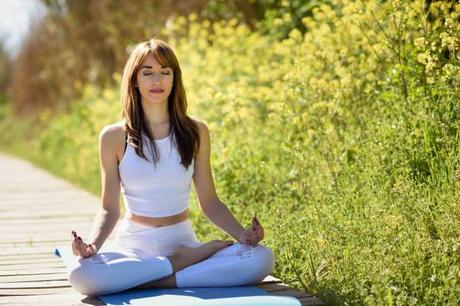Mental health experts, spiritual leaders, and educators all have developed a variety of meditation practices. The variety of forms of meditation suggests that each type of meditation specifically suit certain people's lifestyle or personality.
All types of meditation can largely improve both emotional health and physical wellbeing. There is no prescribed "right way" of meditating. This means that you can freely explore the different types of meditation to find what works for you.

Main Types of Meditations
Transcendental meditation
Point: Silently repeating a mantra with your eyes closedThis is one of the spiritual forms of meditation for heightening mindfulness and spiritual experiences. To meditate you need to sit still and breathe slowly. The primary goal of transcendental meditation is to rise above or transcend above your present state of being.
During a transcendental meditation session, you normally focus on a mantra, a series of words or a single repeated word. The mantra is determined by a teacher depending on a set of complex factors some of which include on the year he/she was trained and the year you were born.
Alternatively, a contemporary version allows you to choose your own mantra. This isn't technically transcendental meditation even though its substantially similar. It can be used to alleviate certain fear an example is repeating "I am not afraid of closed spaces" while meditating.
Mindfulness meditation
Point: Be aware of the present momentMindfulness is crucial in almost all types of meditation. This type of meditation discourages people to dread the future or dwell on the past. It instead urges you as a practitioner to remain present and aware in the moment. The ultimate goal of mindfulness meditation is to encourage you to be aware of your existing surroundings. Lack of judgment is also crucial in mindfulness meditation. This form of meditation has been attributed to:
- Improved memory
- Improved focus
- Less fixation on negative emotions
- Improved satisfaction in relationships
- Reduced impulsive, emotional reactions
You can practice this type of meditation almost anywhere. Including while carrying out mundane tasks like waiting in line. Rather than being burdened by the wait or mundane nature of a situation, mindful meditation allows you to calmly notice sounds, sights and smells around you. You get to experience everything without judgment.
Vipassana meditation
Point: Traditional practices with rules to followThis is an ancient Buddhist meditation practice. This type of mediation means seeing things as they really are.
With vipassana mediation, you can establish a profound connection between your body and mind. To accomplish this, you need disciplined attention to the physical sensation in your body. The interconnectedness achieved through vipassana meditation leaves you with a balanced mind full of compassion and love.
Vipassana meditation also allows you to achieve self-transformation through self-observation. When practicing this type of meditation, you are expected to strictly follow preset rules. The rules include abstaining from stealing, intoxicants, telling lies, killing any species and sexual activity.
Guided meditation
Point: Led by a guide or teacherGuided meditation is also called visualization or guided imagery. During a guided meditation, you usually formulate mental situations or pictures that help to relax. As the name suggests during guided meditation you are typically guided by a teacher or guide. They will often suggest and encourage the use of as many senses as possible to evoke calmness in your relaxation state.
This type of meditation is perfect if you feel more comfortable with being lead through your meditation experience. You can practice guided meditation by listening to a recording, going to a meditation class or following verbal instruction. Guided meditation focuses on manifestation, abundance, physical well-being, and so many more themes.
Zen meditation
Point: Similar to mindfulness meditation but requires some specific steps and posturesZen meditation is also sometimes referred to as zazen. Most people practicing zen meditation need to study under a teacher. This is because it involves specific postures and steps. You need to find a relaxed position, center your focus on breathing and then mindfully observe your thoughts without judgment.
Lots of aspects of zen meditation are similar to mindfulness meditation. Nevertheless, zen meditation requires more practice and discipline. It's perfect if you are seeking a new spiritual path and relaxation at the same time.
Yoga meditation
Point: Physically active form of meditationYoga involves a wide variety of styles and classes. Yoga meditation involves controlled breathing exercises and performing numerous postures. All of which are meant to calm the mind and promote flexibility. Yoga poses normally require high-level concentration and balance. When practicing this type of meditation, it's important to stay in the moment and focus less on any distractions.
Third eye meditation is universal and the most common type of yoga meditation. Moreover, other popular yoga meditations include chakra, gazing (trataka), kundalini, kriya yoga, tantra and sound meditation (nada yoga). Your choice of yoga meditation depends on lots of factors. If you are new to yoga or suffer a health condition, consult with a doctor on which styles are okay for you.
Love kindness meditation
Point: Repeat the message about love and happiness many timesAlso known as Metta meditation, this type of meditation concentrates on cultivating a love and kindness attitude towards everything. Including the things that trigger your stress and even your enemies. During meditation you need to breathe deeply and emphasis on opening your mind to receive loving-kindness. You then send messages of loving kindness to your loved ones, specific people or the world.
Loving-kindness meditation intends on promoting feelings of love and compassion for oneself and others. Therefore, increasing positive emotion. Those affected by resentment, anger, interpersonal conflict, and frustration can largely benefit from this type of meditation.
How to select the best type of meditation for you?
There is a meditation practice best suited to you. Trying out a variety of meditation styles suited to your specific goals is a seamless way to improve the quality of your life emotionally and mentally.
Whether you are looking to achieve spiritual enlightenment, flow through movement, find stillness or even reduce stress. Don't be afraid to try the different types of meditation even when it forces you to step out of your comfort zone.
To find your perfect fit it takes a little or sometimes a lot of trial and error. Gentle and regular meditation practice eventually becomes an enjoyable, supportive and sustaining habit.
As a beginner meditation practitioner open yourself to unlimited possibilities. If one form of meditation isn't comfortable or isn't working for you be open to trying another one.
>>> Read More:Meditation for Beginners - Benefits, Tips & How-To
8 Essential Meditation Tools And Supplies You Need To Have

